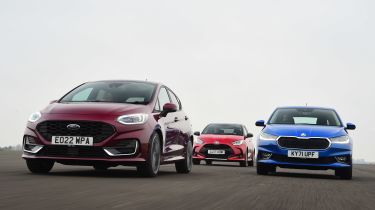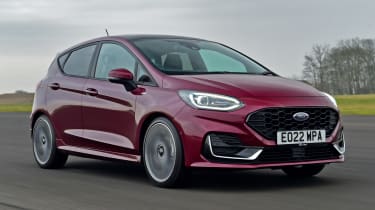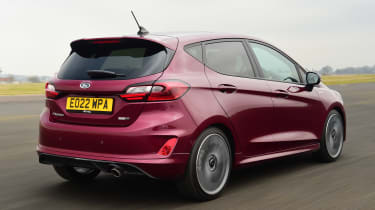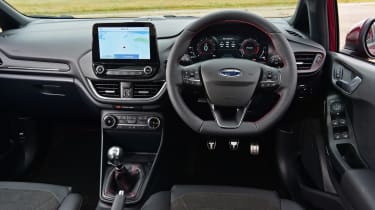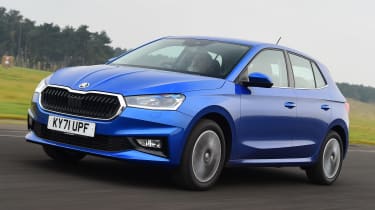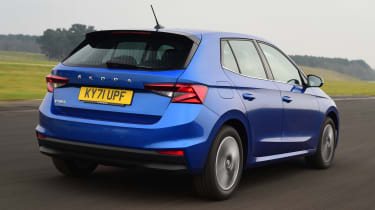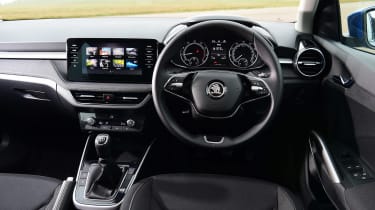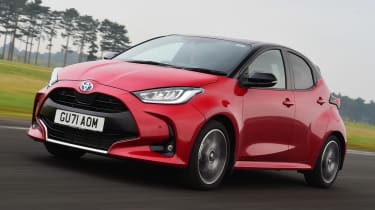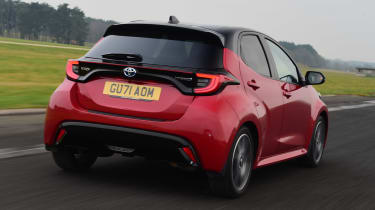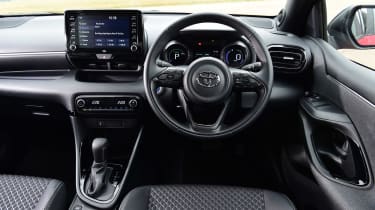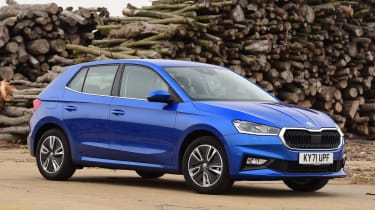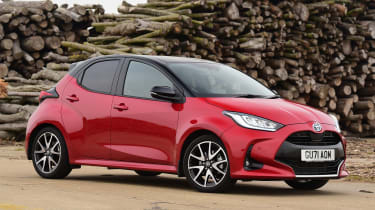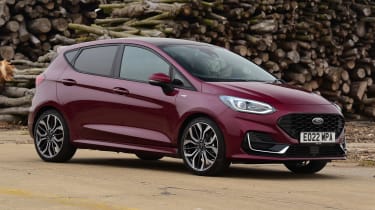Ford Fiesta vs Skoda Fabia vs Toyota Yaris: 2022 group test review
Competition in the supermini class is intense – but is the updated Ford Fiesta still a challenger against the likes of the new Skoda Fabia and Toyota Yaris?
Once upon a time (and not long ago), the Ford Fiesta was the number one supermini on the block. It was the UK’s best seller, and its mix of practicality, style and engaging driving dynamics meant it was a top choice in a class packed with talented rivals.
But time moves on. The Vauxhall Corsa has nabbed the Fiesta’s title as the UK’s number one, while newer supermini rivals have raised the bar in other areas.
To help the Fiesta remain competitive, Ford has updated it for 2022. There’s a subtle new look and more kit, while mild-hybrid tech now features across the range. But has Ford done enough to keep the Fiesta at the cutting edge?
To find out, we’ve lined up two rivals that will push it to its limits. The latest Skoda Fabia offers practicality and quality by the bucketload, and it achieves this while offering fantastic value for money, too.
At a similar price to the Fiesta is the Toyota Yaris. The latest version is built around hybrid drive, so it’s more efficient than the Fiesta, but is that all there is to the Japanese hatch?
Ford Fiesta
| Model: | Ford Fiesta 1.0 EcoBoost 125PS mHEV Titanium |
| Price: | £20,940 |
| Engine: | 1.0-litre 3cyl turbo, 123bhp |
| 0-62mph: | 9.4 seconds |
| Official economy: | 58.9mpg/13.0mpl |
| CO2: | 114g/km |
| Annual road tax: | £155 |
One thing that hasn’t changed with the facelifted Ford Fiesta is the extensive range of variants on offer. Here we’re testing the 123bhp Titanium model, which costs £20,940. However, the car in our pictures is a high-spec ST-Line Vignale variant with a 153bhp version of the EcoBoost petrol engine, which costs £28,135 including options.
Used - available now

2014 Audi
A1 Sportback
91,000 milesManualDiesel1.6L
Cash £6,450
2017 Ford
Fiesta
76,000 milesManualPetrol1.2L
Cash £4,975
2021 MINI
5-Door Hatch
28,985 milesManualPetrol1.5L
Cash £13,629
2021 MINI
5-Door Hatch
28,407 milesAutomaticPetrol1.5L
Cash £15,134Design & engineering
Since this is a mid-life facelift, the updated Fiesta treads a familiar path in terms of its changes. The basic car remains largely untouched, so it’s the same size, shape and layout as before, but Ford has added new styling details and extra equipment to boost the car’s appeal.
The exterior updates focus on the nose and lights, with Ford’s blue oval badge set into the grille rather than sitting above it. LED headlights are now fitted as standard across the range, while at the back, the tail-lights are redesigned with black surrounds. Every trim level also gets unique exterior design elements, including new wheels, to help distinguish them from each other.
Inside, the focus is on improved technology rather than a design revamp. There are new seat fabrics, but the Fiesta features the same eight-inch touchscreen as before, while the physical controls for the air-conditioning have been tweaked slightly. The other addition (but only if you choose the Vignale spec upgrade) are digital dials, which give the cabin a more modern appearance. Unfortunately the quality of the plastics used throughout the cabin hasn’t been improved, and the Fiesta feels a step behind its rivals here in this regard.
Mild-hybrid technology now comes as standard on 123bhp and 153bhp versions of the 1.0 EcoBoost engine, with a 48-volt belt-driven starter-generator that provides energy recovery and assistance when necessary. It means the stop-start system cuts the engine before you’ve come to a halt, while the engine fires up as late as possible when you’re ready to move away again.
The rest of the Fiesta’s underpinnings are the same as before, with a MacPherson strut system up front and a torsion beam at the rear, just like its rivals here. However, that’s no bad thing when it comes to the Fiesta’s driving dynamics.
Driving
The Fiesta has always been the top choice if you want a fun-handling supermini, and that remains the case with this updated model. It’s no exaggeration to say that its keen turn-in, agile chassis and eager responses mean that not only is it a class leader, but it’s also one of the best-handling cars for sale in the UK. The way the Fiesta behaves and reacts to your inputs mean it will inspire confidence in novices, and it’ll put a smile on the face of driving enthusiasts, too.
Not everyone wants a sporty drive, but while the Fiesta’s ride is a little on the firm side – and the 18-inch wheels on the car in our pictures only exacerbate this characteristic – the 16-inch wheels found on Titanium models help to take the edge off. The rest of the controls are user-friendly, too, with a crisp gearshift and steering that weights up naturally the faster you go. Visibility is fine for the most part, although the Fiesta’s thick rear pillars do restrict the view over your shoulder a little.
Ford’s EcoBoost petrol engine is a decent performer. With 123bhp on tap, it’s the most powerful motor here, and delivers a 0-62mph time of 9.4 seconds. However, it has less torque than the Skoda’s unit, and needs working a little harder to make the most of the power available. Thankfully the three-cylinder thrum isn’t too intrusive when using all the revs. Selectable drive modes – Normal, Sport and Eco – adjust the engine’s throttle response.
Practicality
Cabin comfort is decent in the Fiesta. There’s a wide range of adjustment for most drivers to get comfortable at the wheel, and you can either set the driver’s seat low to go with its sporty drive, or high to give a clearer view ahead.
Space up front is good for two, but cabin storage isn’t a match for the Skoda’s. The door bins are small and the tray ahead of the gearlever is only just big enough to fit the latest smartphones.
The Fiesta is even tighter in the back. Access is tricky thanks to the small doors and a low roofline that’s easy to hit your head against, and once you’re in place even the shorter Toyota Yaris has more legroom. Small rear windows add to the cramped feel.
The Fiesta edges ahead of the Yaris again courtesy of its larger 311-litre boot, although that’s still 69 litres behind the Fabia. The 60:40 split-folding back seats drop down flat to create a 1,093-litre cargo area.
Ownership
Ford has upgraded the Fiesta’s safety kit as part of the mid-life update. The main addition is the introduction of a ‘Wrong Way’ system on sat-nav-equipped cars, which warns drivers if they are joining a one-way street or motorway slip road in the wrong direction.
Other innovations include an alert to check the back seats for occupants if the car’s electronics have detected the back doors have been opened, while Ford’s MyKey system returns, allowing owners to set limits for the car’s speed, audio volume and other aspects when registered drivers are behind the wheel.
Running costs
Fitting 48-volt mild-hybrid tech to the Fiesta has reaped benefits in terms of official fuel economy when compared with its predecessor. When driving, it’s clear that the stop-start system is more active than before, but it’s never intrusive in its operation.
Official economy of up to 58.9mpg is better than the less powerful Fabia, and a larger fuel tank means the Ford will go further between fills. However, the full-hybrid Yaris is better still, with a best of 68.8mpg.
Testers’ notes: “Three and five-door Fiestas used to be offered across the range, but now only the base Trend, sporty ST-Line and ST hot hatch can be had with the former.”
Skoda Fabia
| Model: | Skoda Fabia 1.0 TSI 110PS SE L |
| Price: | £19,730 |
| Engine: | 1.0-litre 3cyl turbo, 108bhp |
| 0-62mph: | 10.0 seconds |
| Official economy: | 55.4mpg/12.2mpl |
| CO2: | 117g/km |
| Annual road tax: | £155 |
We’ve already been impressed by the Fabia, but this will be another stern test for Skoda’s latest supermini. It gets off to a good start, though, because this 1.0 TSI model in SE L trim undercuts both rivals here by more than £1,000, at £19,730.
Design & engineering
Skoda sticks with an evolutionary design ethos for the exterior of the Fabia, so while the latest car is all-new underneath, the bodywork looks largely the same as before, save for the Octavia-inspired grille up front and LED lights. It’s handsome enough, but not a car that turns heads.
The Fabia was the last of the VW Group superminis to move to the MQB-A0 platform (after the VW Polo, SEAT Ibiza and Audi A1), and the benefits are to be found in every area. There’s improved refinement, more space inside than before, and the latest safety tech is now included, while cabin quality is a step ahead of the Fiesta’s.
There are soft-touch plastics up front, and the fabric trim on the dashboard is another highlight. Even more impressive are the design details –from the Fabia-branded instrument cowl to the chunky outer air vents and stylish two-spoke steering wheel – which offer a sense of style that was unheard of from the worthy-but-dull Fabias of old. It’s not quite as upmarket in the back, though, where there are plenty of hard plastics still on show.
Power comes from the VW Group’s trusty 1.0 TSI three-cylinder turbocharged petrol unit. Here it makes 108bhp, and there’s 200Nm of torque on tap, too. That’s 20Nm more than the Fiesta’s EcoBoost unit, and helps the Fabia feel punchy, despite its power deficit to the Ford.
Since SE L spec is near the top of the Fabia family, it comes pretty well equipped compared with its rivals here. Keyless start, ambient interior lighting and a large 9.2-inch infotainment display with sat-nav are all included, as is the now-ubiquitous umbrella in the driver’s door. What’s more, the price difference between the Fabia and its rivals here means you can add a few choice extras, such as the Winter Pack (heated windscreen, steering wheel and front seats, £520), and digital dials (£465) and not break the bank.
Driving
While the Ford Fiesta takes a lead for driving dynamics, the latest Skoda Fabia focuses more on comfort. It’s still a reasonably engaging car to drive, with good grip and quick steering, but there’s not much feedback through the wheel, while the soft suspension results in more body roll in corners.
The combination of soft suspension, 16-inch alloy wheels (which feature funky-looking plastic inserts) and tall tyres means the Fabia is a lot smoother to drive than the Fiesta, especially at lower urban speeds. It has a pretty quiet cabin most of the time, too, although we did notice some booming tyre roar when travelling at motorway speeds – this wasn’t present in the other two cars when they were driven on the same stretch of tarmac.
The Fabia’s six-speed manual gearbox offers crisp shifts, but since the three-cylinder TSI engine has 200Nm of torque that’s available from low in the rev range, you don’t feel the need to work the gearlever quite as hard as the Fiesta’s to make progress. A 0-62mph time of 10 seconds exactly is the slowest here, but the Fabia has enough mid-range urge that it’s more than capable of keeping pace with traffic.
Practicality
The Skoda Fabia is longer and has a lengthier wheelbase than its two rivals here, but perhaps more importantly, it’s nearly 5cm wider than the Fiesta, so it feels the most spacious of these three. There’s plenty of adjustment to get comfortable at the wheel, while the dashboard layout and view of the road are both easy to get along with. However, don’t go thinking that the Fabia is a big car – it’s just as easy to position on the road as its narrower rivals here.
Space in the back is generous, with more knee and headroom than in either of its rivals. It’ll be a bit of a squeeze with three across the back, thanks to the Skoda’s large transmission tunnel cramping foot space, but travelling three-up is something that you’re unlikely to even consider in the other two cars. Rear passengers also get their own air vents, while the seatback pockets are split in two, with one regular-sized pocket and a shallow, narrow one designed for smartphones.
Boot space is the best here. There’s 380 litres on offer, which is nearly as much as you get in some compact hatchbacks, while there are hooks and metal lashing eyes that allow you to strap loose items in. If you need to fit child seats, there are the usual two Isofix mounts for the outer rear seats, and another set on the front passenger seat, too.
Ownership
The Fabia is the newest car here, and its five-star Euro NCAP score will have been earned under the most recent test regime, having been done in 2021. The Toyota Yaris also has a five-star rating, and since it was tested in 2020, the scores are comparable. With a five-star rating earned in 2017, the Fiesta can’t be directly compared with its rivals here, but given that Ford has added more safety kit to the car, it’s still going to be a safe machine.
Running costs
While stop-start is fitted to the Fabia, its lack of hybrid tech harms fuel efficiency. An official figure of 55.4mpg would be impressive were it not for the fact that the Fiesta and the Yaris are even more frugal. However, if you cover longer distances, where hybrid tech is less effective, then the differences will narrow.
Poor residuals are another blot on the Fabia’s copybook. A 41.7 per cent rating is nearly 15 per cent behind the Yaris, and seven per cent behind the Fiesta.
Testers’ notes: “If you want a sporty Fabia, then the Monte Carlo can be had with a 148bhp 1.5 TSI petrol engine and DSG gearbox for £23,560.”
Toyota Yaris
| Model: | Toyota Yaris 1.5 VVT-i Icon |
| Price: | £20,820 |
| Engine: | 1.5-litre 3cyl hybrid, 114bhp |
| 0-62mph: | 9.7 seconds |
| Official economy: | 68.8mpg/15.1mpl |
| CO2: | 92g/km |
| Annual road tax: | £145 |
Now in its fourth generation, the Toyota Yaris is an established member of the supermini class. The current car’s arrival in 2020 brought with it refinements to the way the Yaris handled, plus greater efficiency from its hybrid drive system. Here we test the £20,820 entry-level Icon model, although the car in our pictures is a top-spec Excel version, which starts from £23,780
Design & engineering
Of the three cars tested here, the Yaris is the one that sticks closest to the ‘mini’ part of the category name. It’s 168mm shorter than the Skoda, although it’s taller than both rivals here, and slightly wider than the Fiesta.
That makes for a compact, stocky appearance for the Yaris, and its curves, bulges and gaping grille are quite the contrast when compared with the slippery looking Fiesta and straight-edged Fabia. It’s a similar story inside, where the Yaris goes its own way in terms of cabin layout. The dashboard has a lot of black plastic on show, but the heavily sculpted door cards feature additional fabric trim to give it a lift, while build quality is hard to fault.
Under the skin, too, the Yaris goes its own way when compared with its rivals here. It’s based on the smallest version of Toyota’s New Global Architecture and features a conventional MacPherson strut/torsion beam layout front and rear, but it’s the drive system that really sets the car apart in this company.
Toyota has pursued the use of hybrid technology for a long time, and the Yaris features the most compact system that’s ever been developed by the firm. It combines a 90bhp 1.5-litre three-cylinder naturally aspirated petrol engine and a 79bhp electric motor that work in conjunction to drive the front wheels. Drivetrain losses (including the use of a CVT-style gearbox) mean there’s a combined output of 114bhp – which puts the Yaris between its two rivals here – while a lithium-ion battery pack stores energy for the electric motor to use.
The hybrid system isn’t the only technological highlight in the Yaris, because even the entry-level Icon model is equipped with some smart kit. Lane assist, adaptive cruise control, a reversing camera and smartphone connectivity are all included.
Driving
Even though the Yaris is fitted out with hybrid drive (and comes as standard with a space-saver spare wheel, too), Toyota actually quotes a kerbweight for the car that’s lighter than either rival here.
It means that the Yaris feels light and nimble when changing direction, while its compact dimensions help you make the most of this feeling. It can’t match the Fiesta for pure handling thrills, but it’s still capable of putting a smile on your face.
Toyota has more than 25 years of experience with hybrid technology, and the Yaris’s system is well suited to the supermini. The three-cylinder engine thrums away in a similar style to the Ford and Skoda motors, but the Toyota’s CVT gearbox means that when the engine does rev, road speed doesn’t increase at the same rate. However, the electric motor is effective in getting to work at the same time, so you don’t spend as long waiting for the revs to match the car’s speed as you did in older hybrids.
Once under way, the Yaris is quiet and refined, and it rides pretty smoothly. There’s less cabin noise than the Fabia at motorway speeds, while the hybrid system’s tendency to favour electric drive over the petrol engine means the Toyota is relaxing around town. A useful addition is a sound generator, which warns other road users of your presence when using electric drive, but it doesn’t harm cabin refinement.
Practicality
The penalty for the Yaris’s compact dimensions is that there’s less space inside than you’ll find in its rivals here. It’s perfectly acceptable up front, although there is a small glovebox, and the sculpted door trims limit the size of the bins. But it’s in the rear where the biggest sacrifices have been made.
A tall roof means headroom is fine, but knee space isn’t as generous as you’ll find in the Fabia. However, because the Yaris has a longer wheelbase than the Fiesta, it actually has more legroom than the Ford.
At the rear, the Yaris’s boot is tall and narrow in comparison with its rivals here, but the load lip is of a similar height, while there’s only 286 litres of space on offer. Fold the back seats and this increases to 947 litres, which is still a little way behind its rivals here.
Ownership
All three cars come with a basic warranty that covers the car for its first three years of ownership, but Toyota has a trump card up its sleeve. Get your Yaris serviced at a Toyota dealer, and it will add another 12 months of warranty for a maximum of 10 years or 100,000 miles of coverage, whichever comes sooner. You can add this at any time, too, so even if you get your car serviced outside of the network, you can get warranty cover again just by booking a service at a Toyota franchise.
Why you would look beyond the Toyota dealer network is a wonder, though, because the firm’s franchises always rank in the top 10 for customer satisfaction in our Driver Power surveys. In 2021, Toyota ranked sixth, well ahead of Ford and Skoda in 12th and 14th respectively.
Running costs
If you’re looking at one of our trio as a company car, then the Yaris leads the way. Low emissions from the hybrid system put it in the 23 per cent Benefit in Kind bracket, four per cent ahead of the Fiesta.
That means annual tax costs of £949 for a lower-rate taxpayer, but business users can save even more by going for an electric supermini instead.
Testers’ notes: “Bulbous rear arches mean it’s easy to confuse the Yaris with the GR hot hatch from behind, helping the halo model’s appeal rub off on the standard car.”
Verdict
First place: Skoda Fabia
The latest Fabia is a convincing supermini that offers practicality, plenty of cabin space, decent value for money and – dare we say it – a surprising amount of style, especially with that sharp-looking interior. Build quality is great, and while the engine delivers reasonable, if not scintillating performance, the pay-off is the Fabia’s comfortable ride, which will help owners while away their time at the wheel.
Second place: Toyota Yaris
Shrinking the hybrid drive system to fit into the Yaris is a fantastic feat, because it hasn’t compromised the car’s packaging or performance. Owners will be pleased with the low everyday running costs, but there’s no avoiding the fact that the Yaris is a smaller car than the Fabia, and its boot space is compromised. Stronger finance offers when compared with the Fiesta bump it up into second here.
Third place: Ford Fiesta
If a fun drive is a top priority for you when choosing a supermini, then the Ford Fiesta is still top dog. However, there aren’t any other areas where it’s able to take a lead. This mid-life facelift adds more kit and some styling tweaks, but it’s not really enough in the face of some very talented rivals. And while the car’s hybrid tech boosts economy, we wish Ford had pushed even further forward in this regard.
Other options in this category...
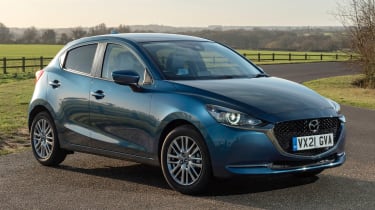
- Model: Mazda 2 115PS GT Sport Tech
- Price: £20,945
- Engine: 1.5-litre 4cyl, 113bhp
While the recently introduced 2 Hybrid is a rebadged Yaris, Mazda’s in-house supermini is still being sold alongside the newcomer. It’s a match for the Fiesta in terms of entertaining handling, while the top-spec GT Sport Tech undercuts the Fiesta Titanium.
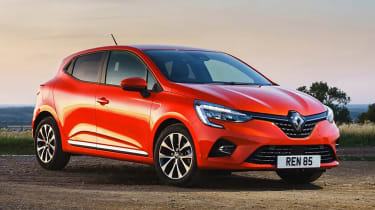
- Model: Renault Clio TCe 90 R.S. Line
- Price: £20,985
- Engine: 1.0-litre 3cyl, 89bhp
Our favourite supermini can’t match our trio here for straight-line performance, but it makes up for that by offering more space, fantastic refinement and an upmarket cabin that feels more expensive than its £21k asking price suggests.
Figures
| Skoda Fabia 1.0 TSI 110PS SE L | Toyota Yaris 1.5 VVT-i Icon | Ford Fiesta 1.0 EcoBoost 125PS mHEV Titanium | |
| On the road price/total as tested | £19,730/£22,915 | £20,820/£20,820 | £20,940/£20,940 |
| Residual value (after 3yrs/36,000) | £8,227/41.7% | £11,847/56.9% | £10,051/48.0% |
| Depreciation | £11,503 | £8,973 | £10,889 |
| Annual tax liability std/higher rate | £1,092/£2,183 | £949/£1,898 | £1,082/£2,164 |
| Annual fuel cost (12k/20k miles) | £1,627/£2,711 | £1,310/£2,183 | £1,530/£2,550 |
| Insurance group/quote/VED | 12/£382/£155 | 13/£421/£145 | 17/£417/£155 |
| Cost of 1st/2nd/3rd service | £456 (2 services) | £500 (2 services) | £330 (1 service) |
| Length/wheelbase | 4,108/2,564mm | 3,940/2,560mm | 4,040/2,493mm |
| Height/width | 1,459/1,780mm | 1,500/1,745mm | 1,476/1,735mm |
| Engine | 3cyl in-line/999cc | 3cyl in-line/1,490cc | 3cyl in-line/999cc |
| Power | 108bhp | 114bhp | 123bhp |
| Torque | 200Nm | 141Nm | 180Nm |
| Transmission | 6-spd man/fwd | CVT auto/fwd | 6-spd man/fwd |
| Fuel tank capacity/spare wheel | 40 litres/£320* | 36 litres/yes | 42 litres/£150 |
| Boot capacity (seats up/down) | 380/1,190 litres | 286/947 litres | 311/1,093 litres |
| Kerbweight/payload/towing weight | 1,194/436/1,100kg | 1,085/530/450kg | 1,275/410/605kg |
| Turning circle | 9.9 metres | 11.0 metres | 10.2 metres |
| Basic warranty (miles)/recovery | 3yrs (60k)/3yrs | 3yrs (unltd)/1yr | 3yrs (60k)/1yr |
| Driver Power manufacturer/dealer pos | 12th/14th | 5th/6th | 25th/12th |
| NCAP: Adult/child/ped./assist/stars | 85/81/70/71/5 (’21) | 86/81/78/85/5 (’20) | 87/84/64/60/5 (’17) |
| 0-62mph/top speed | 10.0 secs/127mph | 9.7 secs/109mph | 9.4 secs/124mph |
| WLTP combined | 50.4-55.4mpg | 57.6-68.8mpg | 54.3-58.9mpg |
| WLTP combined | 11.1-12.2mpl | 12.7-15.1mpl | 11.9-13.0mpl |
| Claimed CO2/tax bracket | 117g/km/28% | 92g/km/23% | 114g/km/27% |
| Airbags/Isofix/park sensors/camera | Six/yes/rear/no | Eight/yes/no/yes | Six/yes/rear/£400* |
| Auto box/lane keep/blindspot/AEB | £1,000/£785/no/yes | Yes/yes/no/yes | £1,500/yes/no/yes |
| Climate control/adaptive cruise | Yes/£470 | Yes/yes | No/£350* |
| Leather/heated seats | No/£520* | No/no | No/£300* |
| Metallic paint/LED headlights | £610/yes | £585/no | £525/yes |
| Keyless entry & go/power tailgate | Yes/no | No/no | Yes/no |
| Sat-nav/digital dashboard | Yes/£465 | £495/no | Yes/no |
| DAB radio/connected services | Yes/yes | Yes/yes | Yes/yes |
| Wireless charge/CarPlay/Android Auto | £620*/yes/yes | No/yes/yes | £425*/yes/yes |
